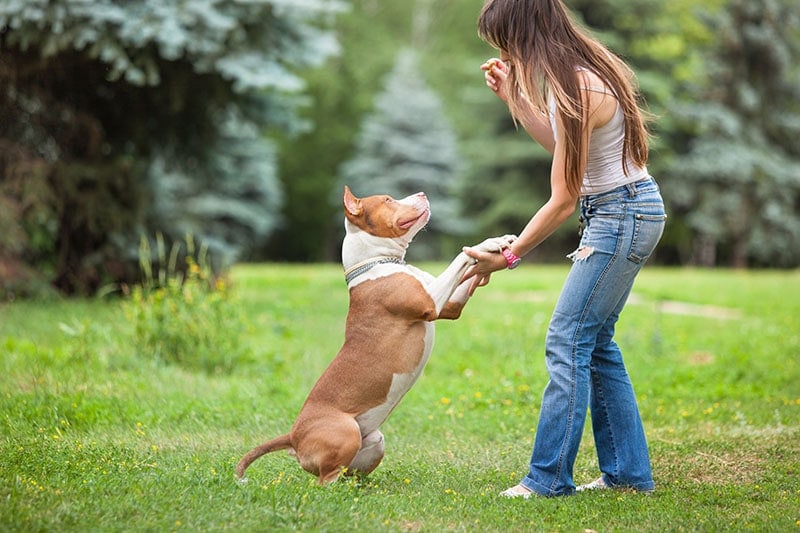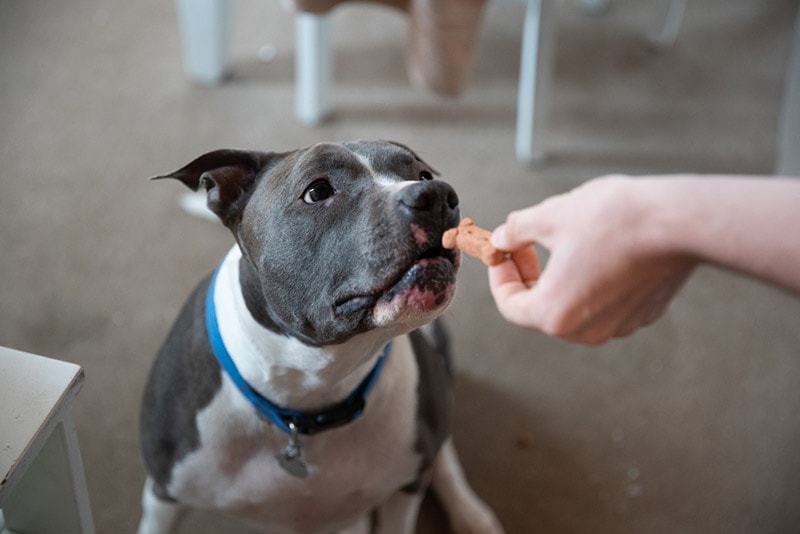How To Train a Pit Bull (8 Expert Tips)
By Kit Copson
Updated on

Contrary to what some think, “Pit Bull” is not a breed in itself but a term used to refer, most often, to mixed-breed dogs that fit certain physical criteria. They typically have broad heads and chests, stocky, muscular, medium-sized bodies, and short, smooth coats, and descend from Bulldog and Terrier-type dogs.
That said, some recognized dog breeds are often categorized as “Pit Bulls”, including the American Staffordshire Terrier and the American Pit Bull Terrier.
A great deal of controversy surrounds Pit Bulls, but a Pit Bull that has been properly socialized and trained is a loving, loyal, and friendly member of the family that enjoys making new friends, both human and canine. They’re very trainable due to being highly intelligent, but they’re also very powerful and energetic, so they benefit most from training with a confident, ideally experienced owner.
In this post, we’ll share some top Pit Bull training tips to help you get started or prepare to inaugurate a lucky Pittie into your home.
The 8 Tips To Train a Pit Bull
1. Start Early
If your Pit Bull is a puppy, this is the perfect time for them to start socializing with other people, dogs, and any other pets in your home you want them to get along with. A puppy Pit Bull that has plenty of positive experiences with people and other pets is highly likely to grow up confident, well-adjusted, and friendly, so this stage is critically important. For reference, puppies aged 3–14 weeks are most likely to retain good habits learned from socialization.
You can start by inviting a few dog-loving friends over (even better if they can bring their dogs) to introduce your puppy to new people and dogs in a calm, supervised manner. If you’re worried, you can always keep your Pit Bull puppy and other dogs on a leash around each other at first until they get used to one another.
If you are adopting a Pit Bull as an adult, it’s a good idea to discuss their history of socialization and how well they get along with people and other animals with the rescue organization staff. This will let you know how far along the Pit Bull is in terms of training and socialization and what kind of work you need to do. On a final note, obedience classes are a great way to help your Pit Bull socialize and learn some important skills.

2. Teach Basic Commands
As well as socializing your Pit Bull with other dogs, it’s a good idea to work on developing a “bank” of commands to have the ready for when they interact with other dogs. This helps you keep control of a variety of situations. For example, you’ll want to teach your Pit Bull to concentrate on you and avoid getting distracted by other dogs by practicing the “watch me” command.
Other important commands are “stay” and “come”, as these are useful for calling your dog away if things start to get out of hand or preventing them from entering into a potentially dangerous situation. You can practice these commands at home where there are no distractions before trying them outdoors.
Avoid letting your Pit Bull get too excited or rough around other dogs and call them off when they start to display this behavior. It’s fine to have fun with other dogs, but if they’re not corrected when things start to get out of control, it can cause problems down the line, especially if the other dog isn’t built to withstand roughhousing.
3. Reward the Behavior You Want to See

One of the first things you’ll want to do when starting training is to find out what your Pit Bull is motivated by. Treats are commonly used to reward good behavior, but some dogs are more motivated by toys or praise, so use whatever your Pit Bull responds to best.
Every time your Pit Bull follows a command like “sit”, “stay”, or “come”, praise their efforts with the phrase “good (insert command)” (for example, “good sit”) and give them a reward. You might want to use a clicker in conjunction with treats. Clicking just before giving the treat is a way of “marking” the behavior they’re being rewarded for.
4. Don’t Forget to Reward Calm Behavior
It’s easy to overlook calm behaviors like your Pit Bull settling down to take a snooze, but rewarding calmness is a great way to show your Pit Bull that calm behavior is a good thing. Try quietly praising your Pit Bull when they’re in a chilled-out state or popping a treat down in front of them.
As Nan Arthur, a Certified Training Partner with Karen Pryor Academy, advises in her book Chill Out Fido! How to Calm Your Dog, when praising calm behavior, you should “make sure your voice is calm and soft, say it once, and resist making eye contact so your dog will not feel obligated to engage. This will really help him get the message that all he has to do to get your attention or a food reward is kick back and relax!”

5. Be Upbeat
Training a dog doesn’t always go smoothly, and it can be discouraging when you feel like you’re not going anywhere. Nevertheless, it’s important to keep a positive attitude and be upbeat during training sessions as your Pit Bull will sense your enthusiasm.
6. Avoid Long Training Sessions
Instead of putting both you and your Pit Bull through long, arduous training sessions, stick to brief 10–15-minute sessions several times per day. Choose one command (like “sit” or “stay”) you want your Pit Bull to perform and focus on that for the duration of the session to avoid overwhelming your pooch.
7. Ensure Your Pit Bull Gets Plenty of Exercise

Pit Bulls are high-energy dogs, so making sure they get plenty of exercise every day will help them release pent-up energy and really focus on your training sessions together.
A Pit Bull with too much energy is more likely to become distracted and destructive, so they need between 1 and 2 hours of exercise per day, which can be broken up into a few walks and play sessions.
8. Be the Pack Leader
One of the most common mistakes dog owners make—especially those who are completely new to training dogs—is letting the dog think that they are the pack leader. A common way people accidentally reinforce this belief in their dogs is by allowing the dog to walk ahead of them and pull when on the leash. This puts the dog in control of the walk entirely.
Instead, have your Pit Bull walk at your side on a loose leash. It’s a good idea to teach the “heel” command, offering rewards based on what motivates your Pit Bull to encourage them to stay at your side.
If your Pit Bull tries to walk or pull ahead of you, stop and let the dog release the tension on the leash itself and come back to your side. There is no need to pull on the leash yourself—your Pit Bull needs to realize that when the leash is slack and they walk calmly at your side, they get to advance. Otherwise, they don’t go anywhere.
Moreover, avoid letting your Pit Bull lunge at other dogs or passersby. If they start to pull toward another dog while on the leash, don’t let them get to the other dog, as this is teaching them that pulling reaps rewards. Instead, distract your Pit Bull with the “watch me” command or take them in another direction.
Conclusion
The most important thing when training your Pit Bull is consistency. This means lots of repetition, being firm but patient and kind, and making sure everyone in your family is following the same training routines.
For example, if you split the walks with another member of your family but are each using different commands (i.e. one of you says “look” while the other says “watch me”), this is confusing for the dog. Everyone needs to be on the same page and be equally determined to raise a well-adjusted, well-behaved dog for the best results.
If you are having difficulties training or socializing your Pit Bull, don’t hesitate to get in touch with a professional trainer who can offer support and guidance.
- See also: 10 Best Collars for Pit Bulls
Featured Image Credit: YouraPechkin, Shutterstock













